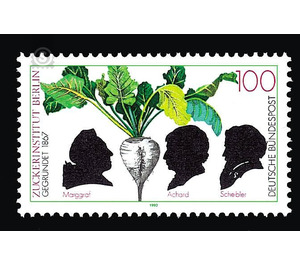125th anniversary the founding of the sugar institute berlin - Germany / Federal Republic of Germany 1992 - 100 Pfennig
Theme: Economy & Industry
| Country | Germany / Federal Republic of Germany |
| Issue Date | 1992 |
| Face Value | 100.00 |
| Color | white |
| Perforation | K 13:12 1/2 |
| Printing Type | Six-color offset printing |
| Stamp Type | Postage stamp |
| Item Type | Stamp |
| Chronological Issue Number | 1472 |
| Chronological Chapter | GER-BRD |
| SID | 972107 |
| In 38 Wishlists | |
The only sugar supplier of importance was originally the sugarcane. In East Asia already proved 10,000 years ago, it was used from about 300 AD in India as planned for the production of sugar. Under the banner of Islam, sugarcane culture came to the Mediterranean. The West took note of this since the First Crusade (1096/99). The sugar trade, which soon flourished in the Mediterranean, found its main source of supply in the Caribbean after the discovery of America by Columbus. The sugar cane plantations of the New World shaped the leading global economic area for the next three centuries. His profit was rooted in the system of slave labor. Slave hunters (Africa), slave traders and slaveholders (America) took for their Christian motherlands, d. H. for the European colonial powers, in the race for the primacy of shame. Three events shook the system of slavery and monopoly position of sugar cane or cane sugar: - the French Revolution with its consequences, - the discovery of beet sugar (1747) and its extraction (1799), - Napoleon's Continental Block, 1806 in Berlin. Berlin became the historic world capital of beet sugar; discovered here by Andreas Sigismund Marggraf (1709-1782), he was first won by his pupil Franz Carl Achard (1753-1821) in Manufakturbetrieb, and in 1798 after his Auslesezüchtungen of turnips since 1784. Under the protective bell of the continental barrier were the first beet sugar factories to overcome the initial difficulties. After the fall of Napoleon, accumulated colonial sugar supplies pushed markets and deprived the young beet sugar factory of the livelihood, throughout Europe, but with a solitary exception: in France. From there, the breakthrough began in the 1920s, which spread to Germany as the second founding wave in the 1930s. The fabrication method, initially based on empiricism and imitation, was replaced by scientific systematics when in March 1867 Carl Scheibler (1827-1899) founded his special laboratory in Berlin, which was taken over by the Sugar Industry Association in the same year and finally became an internationally recognized leading center of ideas understood the relevant science and research. This reputation faded due to the war. Changes after 1945 culminated in the liquidation as an independent institute under partial integration into the Technical University of Berlin 111 years after the establishment of the institute. Tradition care is now primarily the responsibility of the Sugar Museum, which is established in the new institute, which was also chosen for its location in 1901. The worldwide reputation of the Berlin Sugar Institute is based on excellence: development and introduction of investigation methods for the analysis of raw and auxiliary materials as well as intermediate and end products; Research, training center, Arbitration Panel: Assessment, testing and improvement of equipment and fabrication methods; Training of junior staff and the scientific editing of the club magazine with international discussion consequences. One of the pioneering achievements is the initiative (1897) to establish the ICUMSA (International Commission on Uniform Methods of Sugar Analysis), the first international association for the creation and testing of relevant research methods, without which economics and science can not manage specialized engineering studies (1909) with doctoral law (1933), which arose in the reforms of the 70s, - the landmark for women's studies: academic women's courses with almost 300 participants (1901-1923). A proud record overall. (Text: Univ.-Prof. I.R., Dipl.-Br.-Ing, Assessor jur., Dipl.-Ing., Dr. agr. Hubert Olbrich, Director of the Sugar Museum)


